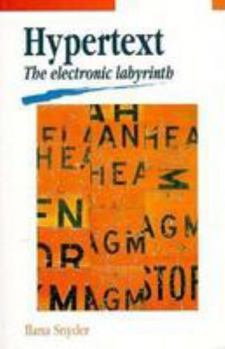Hypertext: The Eletronic Labyrinth
A wonderful book...featuring pragmatic,direct, and clear-eyed scholarship.--Michael Joyce, Vassar CollegeEver since Gutenberg invented movable type we have lived in a culture dominated by print. Now... This description may be from another edition of this product.
Format:Paperback
Language:English
ISBN:0814780792
ISBN13:9780814780794
Release Date:May 1997
Publisher:New York University Press
Length:1 Pages
Weight:0.35 lbs.
Dimensions:0.4" x 5.5" x 8.5"
Customer Reviews
1 rating
An excellent summary of the literature on hypertext
Published by Thriftbooks.com User , 26 years ago
Ilana Snyder's "Hypertext" is the best survey of the academic literature on hypertext yet to appear. Since the early 1990s, academic writers declared that the development of hypertext-- first in stand-alone systems like Hypercard and Storyspace, now in the World Wide Web-- marked a turning-point in the history of literature as significant as the invention of Gutenberg's printing-press. Further, they argued that hypertext's essential qualities-- its instability, its ability to turn readers into writers, its insistence on the connections between texts-- were predicted by literary theorists like Jacques Derrida and Roland Barthes.Drawing on the now-classic works of writers like George Landow's "Hypertext" and Jay David Bolter's "The Writing Space," Snyder's "Hypertext" presents an overview of this discourse. After describing what hypertext is, Snyder considers the impact the development of hypertext has on ideas about authorship; ! on the work of readers; on the relationships between texts. Throughout, "Hypertext" hews closely to the arguments of the now-canonical literature of established hypertext theorists, and this defines both the books strengths and flaws. "Hypertext" is clearly written throughout, and is eminently suitable as an introduction to an important line of argument; but it neither breaks new intellectual ground, nor does it try to correct the flaws of the literature it summarizes. Perhaps most important, theorists describe hypertext as if it were a single, universally-available technology, which it is not: hypertext is in many of its essentials still an imaginary technology, eminently suited to endless theorizing. The fluorescent-bright distinction between print and electronic authors is likewise overplayed. The hypertext literature describes the print author as a god-like eminence, a authoritarian figure who controls every aspect of the experience of reading: in fact,! the character of authorship in print is extremely varied, ! and ranges from journalists (who are often heavily edited, and must obey strict space constraints), to authors of scientific papers (for whom "authorship" is more a signal of work done in the lab or field, rather than at the word processor), to authors of reference works (who are generally anonymous).Despite these problems, anyone interested in new media should be familiar with the literature on hypertext. At its most boring it is quite stimulating, at its best it can be prescient, and at its worst it provokes fruitful argument. Snyder's "Hypertext" is the best introduction to this literature available, and is not likely to be improved upon any time soon.






